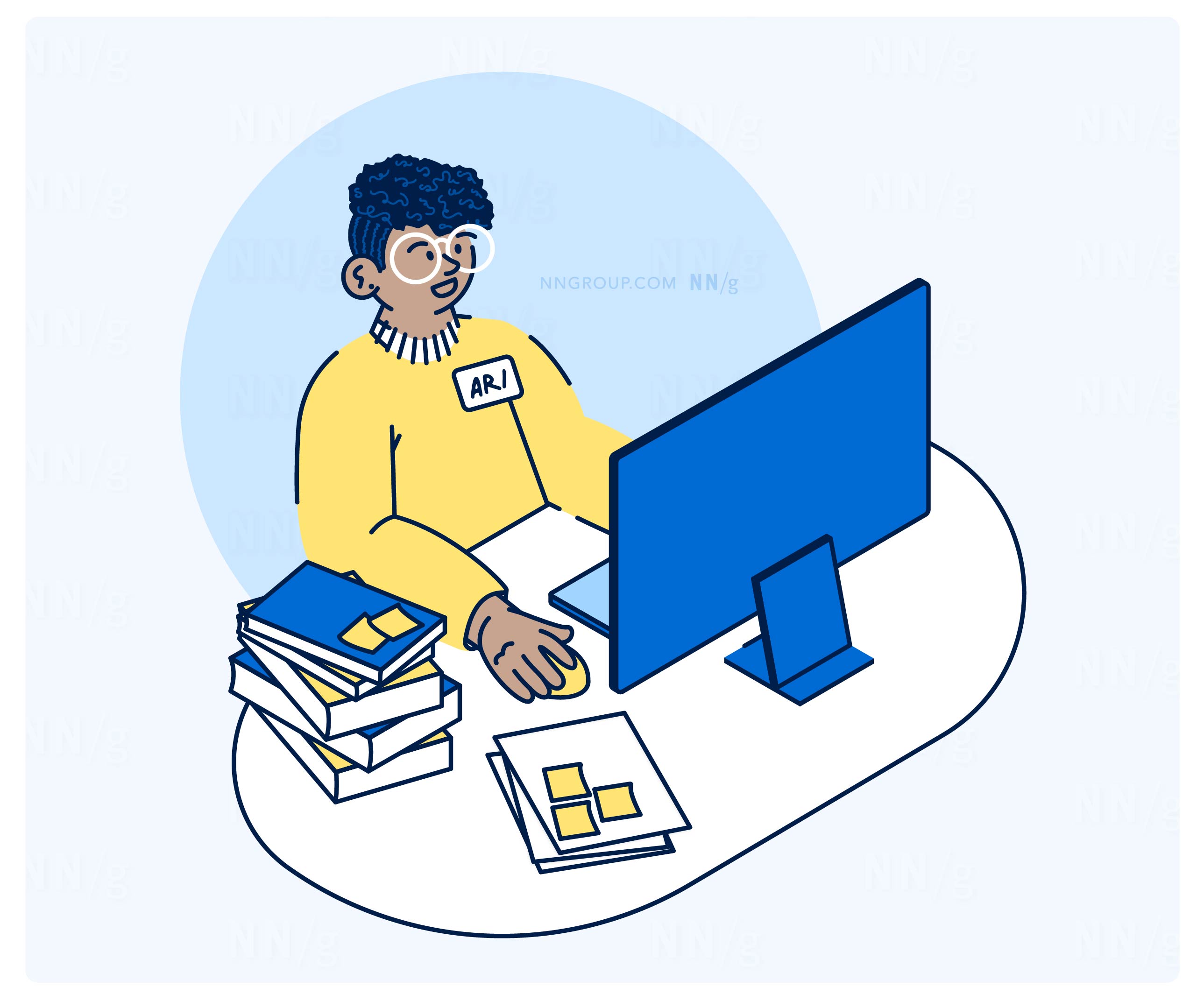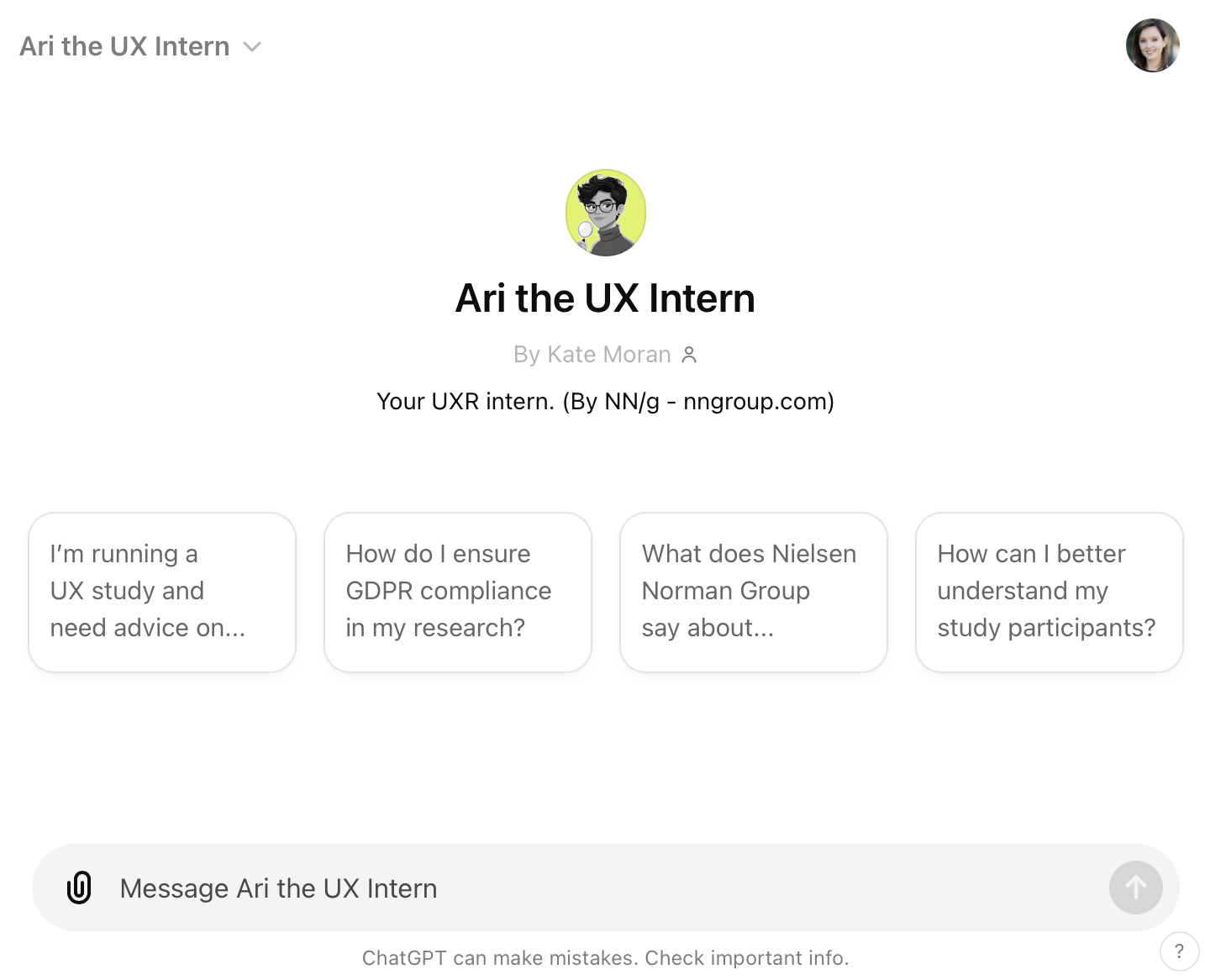Summary:
Work with AI tools in UX the way you’d work with an intern: Treat their work as a first pass, double-check their facts, and provide specific instructions.
We’ve long recommended working with AI tools like you might work with an intern — providing lots of instructions, guidance, oversight, and correction. This analogy helps avoid technical AI jargon and accommodates any level of AI expertise. In this article, I expand that metaphor with a focus on using AI to help with your UX research.
Meet Ari, Your Artificial Intelligence UX Intern
In our field, we sometimes use a persona to represent a group of people as an imaginary individual. Let’s do that for AI in a UX context.
Meet Ari, your new AI-based UX intern.

Ari’s Skills and Limitations
Ari is exceptionally book-smart and knowledgeable about a wide range of subjects. We can imagine Ari as holding a Ph.D. or master’s degree in just about every field. They’re also extremely fast — able to complete complex tasks in just a few seconds.
Unfortunately, that speed and educational background doesn’t always translate to common sense. Ari lacks some critical cognitive abilities, including:
- Sentience or consciousness
- Deep emotional understanding
- Contextual awareness
(These are characteristics and limitations of AI — not human interns.)
If you consider the qualities that make someone an ideal UX professional, it’s clear that this lack of empathy and contextual understanding is a major problem. Ari has a long way to go before they’ll be capable of our work without heavy supervision. This should assuage fears of AI eliminating UX as a role (for now, at least).
Additionally, while Ari is extremely well-read, they’re also a bit naïve. They can’t always tell good advice from bad. This is a particularly big problem in our field. When you ask Ari for information, there’s always a risk that they will regurgitate some nonsense they found from an unqualified LinkedIn or Medium post.
They (like many interns) are eager to please but don’t always fully understand what you want. Unlike human interns, AI takes these tendencies to an extreme. Watch out for Ari’s tendency to blindly agree with your ideas (sycophancy) and to make up fake information and sources when they don’t have the answers you want (hallucination).
Working with Ari
Double-Check Ari’s Advice, Outputs, and Information
You can ask Ari for advice and guidance, but you shouldn’t accept any information you can’t verify or recognize as true. Remember, Ari is your intern, not your mentor. If you’re new to UX, be aware that it’ll be much harder for you to catch Ari’s mistakes and incorrect advice.
For example, you can ask Ari to conduct a “design review” of an interface. But set your expectations appropriately: Know that Ari will miss some issues, misinterpret elements, and propose fairly obvious changes (like “Ensure the font is large enough to read”).
Have Ari Produce Drafts — Not Final Products
You wouldn’t send an intern’s work to a stakeholder without reviewing it, would you? Treat Ari’s work the same way. While Ari can give you a head start on things like UX deliverables and research reporting, they can’t do all your work for you.
Provide Specific Instructions
Ari works best with specific, detailed instructions. Like many interns, Ari needs focused projects and does best with clear, step-by-step directions. Don’t give Ari a big open-ended project without any direction.
For example, don’t just ask Ari to generate an entire research plan for you. Instead, walk Ari through each step of building a research plan (generating research questions, requesting method guidance, filling in screener templates, etc.)
Share Relevant Context
Like most interns, Ari doesn’t have much context for your organization and its goals. To get good results, you need to share relevant details about the organization, business goals, and research needs. (Context is critical when writing prompts for AI.)
Note that, in some cases, the amount of context you’ll need to provide will be substantial.
When to Not Work with Ari
Ari isn’t well suited to every project or need. If you’ve managed an intern in the past, you may have encountered situations where you spent more time helping them than if you’d done the task by yourself.
That can happen often with Ari — the amount of context, instructions, and double-checking they’ll need may not always be worthwhile.
Summary and Custom GPT
When working with AI tools to assist in your research, remember to:
- Always double-check the AI’s work.
- Treat AI-produced documents, communication, and deliverables as a first draft, not a final product.
- Think of AI tools as your intern, not your mentor.
- Provide ample context and specific instructions for best results.
If you’d like to interact with Ari, you can check out our custom GPT. (Note that a paid ChatGPT subscription is required to interact with custom GPTs.)
